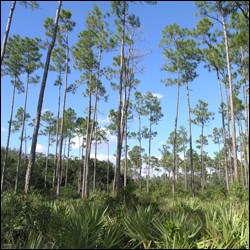
NPS photo Appearances can be deceiving. At first thought, most people think that Everglades National Park (NP) must have excellent air quality. Although all of south Florida is generally perceived to have cleaner air than many other parts of the United States, myriad contaminants lurk within the airshed. Located at the southernmost tip of the Florida peninsula, Everglades NP is nonetheless not far from the Miami metropolitan area as well as highly productive agricultural lands. In addition, the park is downwind from large urban and industrial areas along the Gulf Coast and beyond. Manmade and natural pollutants from sources around the entire world are carried by winds into the upper atmosphere, where they circumnavigate the globe, transported by weather systems. High concentrations of airborne pollutants blow over and into the park, and some of these pollutants locally settle through dry air or are deposited by rain on park lands and in park waters. 
NPS photo Data collected through National Park Service (NPS) air quality programs show that park service units are not islands isolated from the byproducts of an urban, industrial, and agricultural society. Manmade and natural air pollutants are transported long distances and have been detected at all NPS monitoring sites. Air pollution affects natural and cultural resources through visibility reduction, biological and human health effects, and degradation of historic structures and artifacts. 
Air quality within Everglades NP is monitored as part of the NPS national program. Parameters measured include various toxics and mercury, nitrogen, sulfur, ozone, and visibility. The National Atmospheric Deposition Program (NADP) monitors precipitation chemistry. The NADP is a cooperative effort between many different groups, including federal, state, tribal, and local government agencies, educational institutions, private companies, and non-governmental organizations. 
NPS photo by Bill Perry The Clean Air Act As amended in 1977, the Clean Air Act provides one of the most important mandates for protecting air resources in NPS areas. Congress states that one of the purposes of the act is to preserve, protect, and enhance the air quality in national parks, national wilderness areas, national monuments, national seashores, and other areas of special national or regional natural, recreation, scenic, or historic value. National parks larger than 6,000 acres (including Everglades NP) and national wilderness areas larger than 5,000 acres that were in existence before August 1977 are designated Class I areas. The Clean Air Act establishes stringent requirements for Class I areas and affords the greatest air quality protection to these areas. 
Rodney Cammauf, NPS volunteer Toxics and Mercury Airborne toxics, including heavy metals, can be deposited by rain or settle as dust into park ecosystems, where they accumulate in organisms. Everglades NP reports some of the highest mercury levels in the United States. Mercury occurs naturally in the environment and is an introduced contaminant from manmade pollution sources such as coal-burning power plants and municipal and medical waste incinerators. In the presence of sulfate, which is abundant throughout the Everglades from agricultural runoff, mercury converts to methylmercury through a complicated biochemical process. Methylmercury is incorporated into bacteria in periphyton, a complex mixture of algae, cyanobacteria, heterotrophic microbes, and detritus that is attached to submerged surfaces, and which forms the base of the Everglades food chain. Methylmercury is highly toxic to humans and wildlife. This form of mercury is available to organisms through dietary uptake or direct exposure to the surrounding medium and accumulates in tissues (i.e., bioaccumulation), and it increases in concentration at higher trophic levels of the food chain (i.e., biomagnification) because top predators feed on contaminated prey. From insects and fish in the aquatic system, methylmercury is easily transferred through the food chain to birds, terrestrial mammals such as raccoons, and alligators. By the time methylmercury has reached a top-level predator, such as an endangered Florida panther, the mercury concentration may have increased as much as a million times. 
NPS photo by Bill Perry Nitrogen and Sulfur Nitrogen and sulfur compounds deposited from air pollution can harm surface waters, soils, and vegetation. Although nitrogen and sulfur are commonly thought of as being introduced into the Everglades through agricultural runoff, atmospheric deposition also contributes substantial loads to the park. Nitrogen contributes to overenrichment and eutrophication in the park, affecting wetland species that are adapted to the historic low-nutrient environment of the Everglades. Dense blooms of phytoplankton thrive on excess nitrogen and deplete the amount of oxygen in the water, thereby inducing reductions in fish and wildlife populations. Sulfur, in the form of sulfates, plays an essential role in converting inorganic mercury into organic methylmercury, which leads to toxic accumulation of mercury in fish and wildlife. 
U.S. Fish and Wildlife Service photo Ozone Although ozone in the upper atmosphere protects life on earth by absorbing the sun's harmful ultraviolet rays, ozone in the lower atmosphere is an air pollutant that causes respiratory problems in people and injures plants. Ozone forms when nitrogen oxides from vehicle exhaust, power plants, and other sources combine with volatile organic compounds from gasoline, solvents, and vegetation in the presence of sunlight. Although ozone was present at ground level before the Industrial Revolution, peak concentrations are now far higher than pre-industrial levels, and even background concentrations far from sources of pollution are substantially higher. Ozone in the upper troposphere acts as a greenhouse gas, absorbing some of the infrared energy emitted by the earth. Ozone-sensitive plants in Everglades NP include American elder (Sambucus canadensis) and smooth cordgrass (Spartina alterniflora). 
NPS photo Visibility Although smoke from seasonal forest fires occasionally mars park vistas, reduced visibility also results from human-caused haze and fine particles of air pollution. Without the effects of pollution, the average natural visual range in Everglades NP would be about 100 miles. The actual typical visual range is about 40 miles because of air pollution, and on high pollution days, the visual range sometimes drops to less than 20 miles. One upside to air pollution caused by far-away volcanic eruptions is the spectacular sunsets that result. Volcanic ash is spewed into the stratosphere, where the finer particles remain aloft for years and spread around the world. The dust and aerosols scatter light and help produce the vivid, picture-perfect sunsets that Florida is famous for. |
Last updated: March 24, 2021
